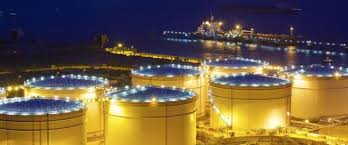Oil & Energy
Mixed Reactions Trail ExxonMobil Divestment
Some capital market operators have expressed mixed feelings to ExxonMobil divestment from the country’s downstream sector.
Some of the operators told The Tide source in Lagos on Thursday that the divestment would encourage more individual marketers to embrace the Nigerian capital market.
But others attributed the divestment to unfavourable policies inherent in the country.
ExxonMobil, a US-based international oil company, on October 19, divested its downstream operations in Nigeria.
The company sold its 60 per cent equity in Mobil Oil Nigeria Plc to Nipco Plc, an indigenous downstream oil and gas company.
The Managing Director, APT Securities and Funds Ltd, Mallam Garbs Kurfi, said that acquisition of the 60 per cent in Mobil by an indigenous company was good for the market.
Kurfi said that being an indigenous company Nipco would not likely seek delisting from the Nigerian Stock Exchange (NSE).
He stated that with the entrance of Nipco, more individual independent marketers would seek quotations on the exchange, thereby deepening the market.
the Chief Executive Officer, SOFUNIX Investment and Communications Ltd., Mr Sola Oni, described the divestment as a normal business decision.
Oni said that the existing staff of the company must be treated fairly.
“I am sure the NSE must be convinced about the motive for divestment, capability of the prospective buyer and value to the company before approval,’’ he said.
However, the Chief Operating Officer, InvestData Ltd., Mr Ambrose Omordion, said that the company’s divestment was due to unfriendly government policies.
Omordion said that corporate governance issue might be a challenge with the ownership of Nipco.
“ExxonMobil selling its 60 per cent holdings to a Nigerian company means that the company will be fully owned and managed by Nigerians.
“And other companies in that sector managed by Nigerians are dragging their feet due to management problems,’’ Omordion said.
He said that investors should be cautious in taking position in the stock for the time being.
National President, Progressive Shareholders Association of Nigeria (PSAN), Mr Boniface Okezie,said the divestment might be in line with American policy to pull out of the country’s downstream sector.
Okezie said that shareholders were not surprised with the divestment because the same thing happened in Texaco now MRS Oil some years ago.
He called on the new buyers to protect the interest of the minority shareholders and as well ensure good corporate governance.
Oil & Energy
Reps Launches Probe Into N200bn CBN Loan To DISCOs
The House of Representatives has launched an investigation into the disbursement and utilisation of the N200billion Central Bank of Nigeria (CBN) loan allocated for the National Mass Metering Programme (NMMP) to Electricity Distribution Companies (DISCOs).
Chairman, House Committee on Public Assets, Rep. Uchenna Okonkwo, disclosed this in a statement in Abuja.
He confirmed that a 19-member sub-committee had been inaugurated to probe the matter thoroughly.
Okonkwo recalled that the NMMP, initiated in 2020, was designed to provide free electricity meters to Nigerian consumers through the Licensed Electricity Distribution Companies (DISCOs).
He said the programme was a joint initiative of the CBN, the Nigerian Electricity Regulatory Commission (NERC), and other stakeholders in the Nigerian Electricity Supply Industry (NESI), aimed at eliminating estimated billing, improve transparency in energy usage, and enhance customer satisfaction.
Speaking on the launch of the NMMP, the Rep said the programme was to be implemented in three phases to ensure the reduction of collection losses and improve market remittances in the industry.
“Under the pilot phase of the programme’s implementation, CBN commenced with the sum of N59.280 billion for procurement and installation of one million meters in 2020 at an interest rate of 9 per cent after a two year moratorium.
“Preliminary research on the NMMP has shown that instead of the pronounced amount of N59.280 billion naira for the phase 0, what was released was N55.4 billion for procurement and installation of 962,832 meters instead of one million meters pronounced by CBN”, he noted.
Okonkwo stated futher that concerns have been raised regarding repayment, with the committee noting discrepancies in the repayment of the funds by the DISCOs.
According to Okonkwo, “Research has also shown that the eleven Electricity Distribution Companies who received the loan have paid back to CBN as refund for the N54.4 billion they received in 2020 without mentioning the 9 per cent interest on the loan.”
The lawmaker, however, said the subsequent phases of the programme, which were expected to significantly expand metering across the country, have stalled, explaining that Phase 1, which was to be funded by the CBN and Deposit Money Banks (DMBs) for 1.5 million meters, and Phase 2, expected to be financed by the World Bank for four million meters, are yet to take off.
He said the House, exercising its constitutional powers under Sections 88(1) and (2) of the 1999 Constitution, resolved to investigate the matter with a view to safeguarding public interest.
According to him, the sub-committee is expected to scrutinise all aspects of the NMMP funding, from disbursement and meter procurement to distribution and repayment mechanisms.
The 19-member committee comprises Reps. Obed Shehu, Ali Shettima, Abel Fuah, Salisu Koko, Ahmed Munir, Sani Umar Bala, Gbefwi Jonathan, Abdulmaleek Danga, Chinedu Obika, and Okunlola Lanre.
Others include Reps. Abass Adekunle, Akinosi Akanni, Obuzor Victor, Peter Akpanke, Ngozi Lawrence, Ogah Amobi Godwin and Ikeagwuonu Onyinye.
It would be noted that the NMMP was expected to be a game-changer in Nigeria’s power sector by reducing estimated billing, enhancing energy accountability, and restoring consumer trust.
However, the current revelations point to implementation failures and possible mismanagement of public funds.
Analysts believe that the outcome of the House probe could lead to reforms in electricity metering policy and strengthen regulatory oversight of loan disbursements to DISCOs.
Oil & Energy
“Renaissance Energy, NNPC JV Donate ICU Equipment To RSUTH

Renaissance Africa Energy Company Limited and its joint venture partners, including the Nigerian National Petroleum Company Limited (NNPC), have donated vital medical equipment and essential drugs to the Intensive Care Unit (ICU) of the Rivers State University Teaching Hospital (RSUTH).
Among the equipment are three ventilators, a laser therapy machine, as well as significant supply of seed stock drugs targeted at enhancing the hospital’s capacity to provide critical care and ensuring consistent drug availability.
Speaking at the Handover Ceremony at Renaissance Energy Headquarters, in Port Harcourt, the General Manager, Relations and Sustainable Development, Renaissance Africa Energy, Igo Weli, said, “The gesture by Renaissance and our partners is to enhance the capacity of the hospital to provide critical care to patients in need; improve the training of upcoming healthcare personnel; and provide support to dedicated healthcare professionals in their mission to save lives and improve patient outcomes.”
The Chief Upstream Investment Officer, NNPC, Oluwaseyi Omotowa, noted that the donations were part of a broader social intervention strategy of the Renaissance-operated joint venture.
Omotowa, who was represented by the Lead, Stakeholder Relations, NNPC Upstream Investment Management Services, Mrs. Uzo Ejidoh, further said “the JV has a deliberate corporate social responsibility strategy to serve the people.
“This is an unchanging commitment, hence our steadfast support and investment in social impact projects for the healthcare sector to continue to transform lives”.
Recieving the donations, the Chief Medical Director, RSUTH, Professor Chizindu Alikor, stated that the hospital was committed to the delivery of excellent healthcare along with research and training.
Alikor said, “The teaching hospital is on an upward trajectory. The ICU facilities were over stretched, and we are excited that our request to Renaissance and its partners for assistance was granted.
The CMD expressed the hospital’s confidence in Renaissance’s capacity and people-centric interventions, especially as it concerns Corporate Social Responsibility (CSR) in the health space.
By: Lady Godknows Ogbulu
Oil & Energy
Tight Now, Loose Later: Oil Futures Flash Warning

Last week, OPEC+ announced it will once again accelerate the pace of unwinding of production cuts, with output targets for June increasing by 411,000 barrels per day, equivalent to three monthly increments.
This follows a similar move in April, with the organization appearing willing to stay the course amid low oil prices and fears of weakening demand.
We reported that global crude inventories remain low enough, thus giving OPEC+ a window to scale back its voluntary cuts until the market surplus finally arrives.
Saudi Arabia appears intent on “punishing” OPEC+ rascals such as Kazakhstan and Iran for repeatedly violating their quotas.
Commodity analysts at Standard Chartered have reported that the latest OPEC survey of secondary sources reveals that Kazakhstan’s crude oil output clocked in at 1.852 mb/d in March, 384 kb/d above its OPEC+ quota.
Further, the country also failed to keep its promise to cut 38 kb/d in compensation for overproduction in March, bringing its total overproduction to 422 kb/d.
The same scenario is expected to unfold in the coming months. Kazakhstan produced 240 kb/d more y/y in March, a sharp contrast from the other eight OPEC+ members who produced a combined 612 kb/d less.
And now, the oil futures markets are sending a dire warning that oil bulls could find themselves in trouble quite soon due to a combination of the OPEC+ output hike and Trump’s tariffs.
Oil futures curve has formed a rare “smile” shape, a structure Morgan Stanley says was last seen briefly in February 2020 just before the infamous oil price crash.
On Wednesday, Brent futures’ July contract was trading at a premium of 74 cents to the October contract, a market structure known as backwardation, foreshadowing immediate tight supply.
However, prompt prices from November have formed a contango, with forward prices flipping to a discount, indicating oversupply as traders predict Trump’s tariffs will eventually weaken oil demand. Having backwardation and contango together leads to the rare “smile” shaped curve.
According to the latest available data by the International Energy Agency (IEA), global oil inventories stood at 7.647 billion barrels in February, down from 7.709 billion barrels for last year’s corresponding period and close to the bottom of their historical five-year range.
Meanwhile, refiners’ appetite for crude is climbing ahead of the peak driving season in July and August, “Refinery maintenance in the Atlantic basin will start to taper off, increasing oil demand (for refining)… Summer driving should provide some support,” BNP Paribas analyst told Reuters.
Global oil demand is expected to rise by 1.3 million barrels per day in the third quarter of the current year, up from an average of 104.51 million bpd in the second quarter, the IEA has predicted.
The 1 million bpd output increases announced by OPEC+ so far, coupled with another 400 kb/d increase in July, almost matches the predicted demand increase, implying oil markets will not face a surplus till late in the year.
Meanwhile, oil prices jumped in Thursday’s session after the Trump administration announced it has struck a trade deal with the UK. Brent crude for July delivery was up 2.7% to trade at $62.75/bbl at 12.50 pm ET while WTI crude contract for June delivery added 3.0% to change hands at $59.86 per barrel. However, terms of the deal appear to fall well short of the “comprehensive” package Trump earlier touted.
According to Trump, UK Prime Minister, Keir Starmer, will further reduce non-tariff barriers and fast-track U.S. goods into his country.
Meanwhile, another solid week of jobless claims underscored the Federal Reserve’s ongoing unwillingness to cut rates. U.S. jobless claims fell 13,000 to 228,000 for the period ending on May 3.
Continued claims, however, clocked in at just over 1.9 million, near the highest levels since 2021, suggesting workers are still finding it difficult to secure new jobs as the economy stalls.
That said, commodity analysts at Standard Chartered have predicted that path of least resistance for oil prices is lower in the coming months, with oil prices to remain low before beginning a gradual recovery later in the year as U.S. oil output declines.
StanChart, however, says there’s some technical support in the short-term, with fundamentals remaining fairly positive. Recently, StanChart cut its 2025 oil price forecast to $61/bbl from $76 and also lowered its 2026 forecast to USD 78/bbl from $85 citing Trump’s tariffs.
By: Alex Kimani
-

 Niger Delta7 hours ago
Niger Delta7 hours agoPolice Arrest 95 Cultists, Recover Firearms In Benin Raids
-

 Politics1 hour ago
Politics1 hour agoWhy Legislature’s Still Executive’s Appendage In Nigeria – State Lawnaker
-

 Sports7 hours ago
Sports7 hours agoPRIVATE SECTOR IS KEY TO GRASSROOTS SPORTS DEVELOPMENT – NSC Chairman
-

 Rivers23 mins ago
Rivers23 mins agoEmolga Administrator Tasks Stakeholders On Peace, Dev.
-

 News8 hours ago
News8 hours agoNSCDC, Navy, Army uncover illegal refinery in Anambra
-

 Opinion1 hour ago
Opinion1 hour agoNigeria’s Insecurity And Co-Existence
-

 Sports7 hours ago
Sports7 hours agoBrighton Whip Wolves 2-0
-

 Business1 hour ago
Business1 hour agoFG Bans Waivers For Threaded Pipes

